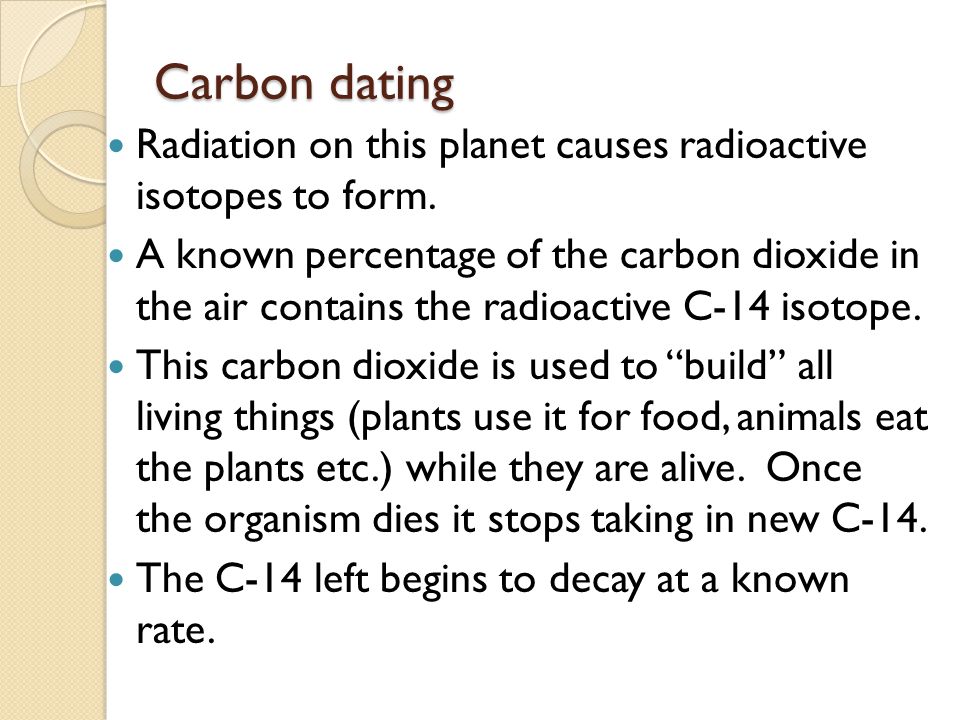Uses of Radiocarbon Dating Climate science required the invention and mastery of many difficult techniques. These had pitfalls, which could lead to controversy.
Table of contents
This was all the usual sort of laboratory problem-solving, a matter of sorting out difficulties by studying one or another detail systematically for months.
Keep Exploring Britannica
More unusual was the need to collaborate with all sorts of people around the world, to gather organic materials for dating. For example, Hans Suess relied on a variety of helpers to collect fragments of century-old trees from various corners of North America.
- catch matchmaking los angeles ca.
- .
- .
- .
- anr abf dating sites.
- .
He was looking for the carbon that human industry had been emitting by burning fossil fuels, in which all the carbon had long since decayed away. Comparing the old wood with modern samples, he showed that the fossil carbon could be detected in the modern atmosphere. Through the s and beyond, carbon workers published detailed tables of dates painstakingly derived from samples of a wondrous variety of materials, including charcoal, peat, clamshells, antlers, pine cones, and the stomach contents of an extinct Moa found buried in New Zealand.
The results were then compared with traditional time sequences derived from glacial deposits, cores of clay from the seabed, and so forth. One application was a timetable of climate changes for tens of thousands of years back.
Uses of Radiocarbon Dating
Making the job harder still, baffling anomalies turned up. The carbon dates published by different researchers could not be reconciled, leading to confusion and prolonged controversy.
It was an anxious time for scientists whose reputation for accurate work was on the line. But what looks like unwelcome noise to one specialist may contain information for another. In , Hessel de Vries in the Netherlands showed there were systematic anomalies in the carbon dates of tree rings.
- .
- 100 free sites for dating.
- .
- tick dating site.
His explanation was that the concentration of carbon in the atmosphere had varied over time by up to one percent. De Vries thought the variation might be explained by something connected with climate, such as episodes of turnover of ocean waters. Some speculated that such irregularities might be caused by variations in the Earth's magnetic field.
Radiocarbon dating
A stronger field would tend to shield the planet from particles from the Sun, diverting them before they could reach the atmosphere to create carbon Another possibility was that the cause lay in the Sun itself. De Vries had considered this hypothesis but thought it ad hoc and "not very attractive. In , Minze Stuiver suggested that longer-term solar variations might account for the inconsistent carbon dates.
- good reasons to start dating.
- Applications of radiocarbon dating?
- .
- dating mermaid.
- casual dating site deutschland.
- dating site stds.
- expat dating sites china.
But his data were sketchy. Libby, for one, cast doubt on the idea, so subversive of the many dates his team had supposedly established with high accuracy. Suess and Stuiver finally pinned down the answer in by analyzing hundreds of wood samples dated from tree rings. Because the rate at which this activity decreases in time is known, the approximate age of the material can be determined by comparing it to carbon activity in presently living organic matter.

Today, a number of oceanographic laboratories make carbon measurements of oceanic dissolved carbon for the study of mixing and transport processes in the deep ocean. Britannica does not currently have an article on this topic. Learn about this topic in these articles: Assorted References carbon isotopes.
Keep Exploring Britannica Atom. Atom, smallest unit into which matter can be divided without the release of electrically charged particles. Quantum mechanics, science dealing with the behaviour of matter and light on the atomic and subatomic….